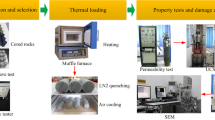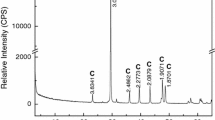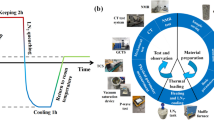Abstract
As a new waterless fracturing technology, liquid nitrogen (LN2) fracturing is expected to be applied in the exploitation of geothermal energy. Therefore, understanding the thermomechanical features of hot rock under LN2-cooling is essential. In this study, a battery of laboratory-scale experiments on the marble with the temperatures of 25–300 °C are conducted to reveal the changes in their structure damage and brittleness properties after both the air-cooling and LN2-cooling treatments. Following LN2 cooling, the P-wave velocity, compression strength, elastic modulus, and brittleness index of the marble reduce, while the complexity of pores, macro-pore volume, and porosity increase. The higher the marble’s temperature is, the more significant the changes in these properties are. The extensive changes in the thermomechanical behaviors of the marble are induced by LN2-cooling compared with air-cooling. The results indicate that LN2-cooling can produce greater damage than air-cooling and the influence of LN2 thermal shock can be strengthened by increasing the marble temperature. After the thermal shock, the brittleness properties of the marble are closely related to its structural damage degree. During LN2 thermal shock, there are two primary contributions to the structural damage. The first is the temperature gradient inside the heated marble, which can generate surface macro-fractures, while the second is the heterogeneity and anisotropy of thermal expansion coefficients of minerals. Inter-granular cracks can be readily produced by the difference in thermal expansion of adjacent minerals and trans-granular cracks can be produced due to the difference of thermal expansion coefficients in different crystallographic directions of the mineral.
Article highlights
-
Significant deterioration in physical and mechanical features of heated marble after LN 2 cooling is induced.
-
The brittleness properties of the marble are closely related to its structural damage degree.
-
In the LN 2 cooling thermal shock of the heated marble the macro fractures are induced by the temperature gradient and the micro cracks are generated by anisotropy of thermal expansion coefficient















Similar content being viewed by others
References
Asai P, Panja P, Velasco R, McLennan J, Moore J (2018) Fluid flow distribution in fractures for a doublet system in enhanced geothermal systems (egs). Geo- thermics 75:171–179
Brotóns V, Tomás R, Ivorra S, Alarcón JC (2013) Temperature influence on the physical and mechanical properties of a porous rock: San julian’s calcarenite. Eng Geol 167:117–127
Cai CZ, Li GS, Huang ZW, Shen ZH, Tian SC, Wei JW (2014) Experimental study of the effect of liquid nitrogen cooling on rock pore structure. J Natl Gas Sci Eng 21:507–517
Deb P, Duber S, Carducci GC, Clauser (2020) Laboratory-scale hydraulic fracturing dataset for benchmarking of enhanced geothermal system simulation tools. Sci Data 7(1):220. https://doi.org/10.1038/s41597-020-0564-x
Dong ZH, Sun Q, Ranjith PG (2019) Surface properties of grayish-yellow sandstone after thermal shock. Environ Earth Sci 78(14):1–13
Ersoy H, Kolayli H, Karahan M, Karahan HH, Sunnetci MO (2019) Effect of thermal damage on mineralogical and strength properties of basic volcanic rocks exposed to high temperatures. Bull Eng Geol Env 78(3):1515–1525
Ge ZL, Sun Q, Xue L, Wang SF (2021) The influence of temperature and confining pressure on the cracks damage threshold and shape parameter m of igneous rock. Geomech Geophys Geo-Energy Geo-Resour 7(3):1–14
Gielen D, Boshell F, Saygin D, Bazilian MD, Wagner N, Gorini R (2019) The role of renewable energy in the global energy transformation. Energ Strat Rev 24:38–50
Hodot BB (1966) Coal and gas outburst (Chinese translation). China Industry Press, Beijing
Hou P, Gao F, Gao YN, Yang YG, Cai CZ (2018) Changes in breakdown pressure and fracture morphology of sandstone induced by nitrogen gas fracturing with different pore pressure distributions. Int J Rock Mech Min Sci 109:84–90
Hou P, Su SJ, Liang X, Gao F, Cai CZ, Yang YG, Zhang ZZ (2021) Effect of liquid nitrogen freeze-thaw cycle on fracture toughness and energy release rate of saturated sandstone. Eng Fract Mech 258:108066
Hou P, Liang X, Gao F, Dong JB, He J, Xue Y (2021) Quantitative visualization and characteristics of gas flow in 3d pore-fracture system of tight rock based on lattice boltzmann simulation. J Natl Gas Sci Eng 89:103867
Hou P, Liang X, Zhang Y, He J, Gao F, Liu J (2021c) 3d multi-scale reconstruction of fractured shale and influence of fracture morphology on shale gas flow. Nat Resour Res 30(3):2463–2481
Hou P, Xue Y, Gao F, Dou F, Su S, Cai C, Zhu C (2022) Effect of liquid nitrogen cooling on mechanical characteristics and fracture morphology of layer coal under Brazilian splitting test. Int J Rock Mech Min Sci 151:105026
Hucka V, Das B (1974) Brittleness determination of rocks by different methods. Int J Rock Mech Min Sci Geomech Abstr 11(10):389–392
Jacobsen RT, Stewart RB, Jahangiri M (1986) Thermodynamic properties of nitrogen from the freezing line to 2000 k at pressures to 1000 mpa. J Phys Chem Ref Data 15:735–909
Janssen MTG, Barnhoorn A, Draganov D, Wolf KAA, Durucan S (2021) Seismic velocity characterisation of geothermal reservoir rocks for co2 storage performance assessment. Appl Sci-Basel 11:3641
Kana JD, Djongyang N, Raïdandi D, Nouck PN, Dadje A (2015) A review of geophysical methods for geothermal exploration. Renew Sustain Energy Rev 44:87–95
Kim K, Kemeny J, Nickerson M (2014) Effect of rapid thermal cooling on mechanical rock properties. Rock Mech Rock Eng 47:2005–2019
Kitamura K, Takahashi M, Mizoguchi K, Masuda K, Ito H, Song SR (2010) Effects of pressure on pore characteristics and permeability of porous rocks as estimated from seismic wave velocities in cores from tcdp hole-a. Geophys J Int 182(3):1148–1160
Kurek KA, Heijman W, Ophem JV, Gędek S, Strojny J (2021) The contribution of the geothermal resources to local employment: case study from Poland. Energy Rep 7:1190–1202
Lepillier B, Daniilidis A, Gholizadeh ND, Bruna P, Kummerow J, Bruhn D (2019) A fracture flow permeability and stress dependency simulation applied to multi-reservoirs, multi-production scenarios analysis. Geotherm Energy 7:24
Li Y, Huang D, Li XA (2014) Strain rate dependency of coarse crystal marble under uniaxial compression: Strength, deformation and strain energy. Rock Mech Rock Eng 47(4):1153–1164
Li YW, Zhou LH, Li DP, Zhang SC, Tian FC, Xie ZM, Liu B (2020) Shale brittleness index based on the energy evolution theory and evaluation with logging data: a case study of the Guandong block. ACS Omega 5(22):13164–13175
Liang X, Hou P, Xue Y, Yang XJ, Gao F, Liu J (2021a) A fractal perspective on fracture initiation and propagation of reservoir rocks under water and nitrogen fracturing. Fractals. https://doi.org/10.1142/S0218348X21501899
Liang X, Hou P, Yang XJ, Xue Y, Teng T, Gao F, Liu J (2021b) On estimating plastic zones and propagation angles for mixed mode I/II cracks considering fractal effect. Fractals. https://doi.org/10.1142/S0218348X22500116
Liang, L., Liu, X., Xiong, J., Wu, T., & Ding, Y. (2017). New model to evaluate the brittleness in shale formation. Paper presented at the Proceedings of the international geophysical conference, Qingdao, China
Liu S, Xu JY (2015) An experimental study on the physico-mechanical properties of two post-high-temperature rocks. Eng Geol 185:63–70
Luque A, Leiss B, Alvarez-Lloret P, Cultrone G, Siegesmund S, Sebastian E, Cardell C (2011) Potential thermal expansion of calcitic and dolomitic marbles from andalusia (Spain). J Appl Crystallogr 44:1227–1237
Mayama H, Tsujii K (2006) Menger sponge-like fractal body created by a novel template method. J Chem Phys 125(12):124706
Peng RD, Ju Y, Wang JG, Xie HP, Gao F, Mao LT (2015) Energy dissipation and release during coal failure under conventional triaxial compression. Rock Mech Rock Eng 48(2):509–526
Qin L, Wang P, Li SG, Lin HF, Wang RZ, Wang P, Ma C (2021) Gas adsorption capacity changes in coals of different ranks after liquid nitrogen freezing. Fuel 292:120404
Qin L, Ma C, Li SG, Lin HF, Wang P, Long H, Yan DJ (2021) Mechanical damage mechanism of frozen coal subjected to liquid nitrogen freezing. Fuel 309:122124
Read HE, Hegemier GA (1984) Strain softening of rock, soil and concrete-a review article. Mech Mater 3:271–294
Sang G, Liu S, Elsworth D (2020) Quantifying fatigue-damage and failure-precursors using ultrasonic coda wave interferometry. Int J Rock Mech Min Sci 131:104366
Saroglou C, Kallimogiannis V (2017) Fracturing process and effect of fracturing degree on wave velocity of a crystalline rock. J Rock Mech Geotech Eng 9:797–806
Shao S, Wasantha PLP, Ranjith PG, Chen BK (2014) Effect of cooling rate on the mechanical behavior of heated strathbogie granite with different grain sizes. Int J Rock Mech Min Sci 70:381–387
Shao ZL, Wang Y, Tang XH (2020) The influences of heating and uniaxial loading on granite subjected to liquid nitrogen cooling. Eng Geol 271:105614
Su SJ, Hou P, Gao F, Liang X, Ding RY, Cai CZ (2022) Changes in mechanical properties and fracture behaviors of heated marble subjected to liquid nitrogen cooling. Eng Fract Mech 261:108256
Sun H, Sun Q, Deng WN, Zhang WQ, Lu C (2017) Temperature effect on microstructure and p-wave propagation in linyi sandstone. Appl Therm Eng 115:913–922
Wu XG, Huang ZW, Li GS, Li R, Yan PS, Deng X, Dai XW (2018a) Experiment on coal breaking with cryogenic nitrogen jet. J Petrol Sci Eng 169:405–415
Wu XG, Huang ZW, Li R, Zhang SK, Wen HT, Huang PP, Zhang CC (2018b) Investigation on the damage of high-temperature shale subjected to liquid nitrogen cooling. J Nat Gas Sci Eng 57:284–294
Wu XG, Huang ZW, Song HY, Zhang SK, Cheng Z, Li R, Dai XW (2019a) Variations of physical and mechanical properties of heated granite after rapid cooling with liquid nitrogen. Rock Mech Rock Eng 52(7):2123–2139
Wu XG, Huang ZW, Zhang SK, Cheng Z, Li R, Song HY, Huang PP (2019b) Damage analysis of high-temperature rocks subjected to ln2 thermal shock. Rock Mech Rock Eng 52(8):2585–2603
Xi Z, Tang S, Wang J, Yi J, Guo Y, Wang K (2018) Pore structure and fractal characteristics of niutitang shale from China. Minerals 8:163
Yang JP, Chen WZ, Yang DS, Tian HM (2017) Investigating the permeability of marble under moderate pressure and temperature. Geofluids. https://doi.org/10.1155/2017/4126908
Zeisig A, Siegesmund S, & Weiss T (2002). Thermal expansion and its control on the durability of marbles. Paper presented at the Natural Stone, Weathering Phenomena, Conservation Strategies and Case Studies, London
Zhang ZZ, Gao F (2015) Experimental investigation on the energy evolution of dry and water-saturated red sandstones. Int J Min Sci Technol 25(3):383–388
Zhang W, Sun Q, Hao S, Geng J, Lv C (2016) Experimental study on the variation of physical and mechanical properties of rock after high temperature treatment. Appl Therm Eng 98:1297–1304
Zhang F, Zhao J, Hu D, Skoczylas F, Shao J (2017) Laboratory investigation on physical and mechanical properties of granite after heating and water-cooling treatment. Rock Mech Rock Eng 51(3):677–694
Zhang F, Zhao JJ, Hu DW, Skoczylas F, Shao JF (2018) Laboratory investigation on physical and mechanical properties of granite after heating and water-cooling treatment. Rock Mech Rock Eng 51(3):677–694
Zhao HB, Yin GZ, Chen LJ (2009) Experimental study on effect of temperature on sandstone damage. Chin J Rock Mech Eng 28(Supp. 1):2784–2788
Zhu ZN, Tian H, Mei G, Jiang GS, Dou B (2020) Experimental investigation on physical and mechanical properties of thermal cycling granite by water cooling. Acta Geotech 15(7):1881–1893
Zhu ZN, Kempka T, Ranjith PG, Tian H, Jiang GS, Dou B, Mei G (2021) Changes in thermomechanical properties due to air and water cooling of hot dry granite rocks under unconfined compression. Renew Energy 170:562–573
Acknowledgements
This work had been financially supported by the Open Fund of the State Key Laboratory of Coal Resources in Western China, Xi’an University of Science and Technology (No. SKLCRKF20-03), the National Natural Science Foundation of China (Nos. 51904270, 52004201, and 52078477), and China Postdoctoral Science Foundation (Nos. 2020M673451 and 2020M683677XB).
Author information
Authors and Affiliations
Corresponding author
Ethics declarations
Conflict of interest
The authors declared that there is no conflict of interest.
Additional information
Publisher's Note
Springer Nature remains neutral with regard to jurisdictional claims in published maps and institutional affiliations.
Rights and permissions
About this article
Cite this article
Hou, P., Su, S., Zhang, Y. et al. Effect of liquid nitrogen thermal shock on structure damage and brittleness properties of high-temperature marble. Geomech. Geophys. Geo-energ. Geo-resour. 8, 69 (2022). https://doi.org/10.1007/s40948-022-00381-7
Received:
Accepted:
Published:
DOI: https://doi.org/10.1007/s40948-022-00381-7




